David Bishop's Ancestors |
Click on a name for info, click on an arrow to follow that branch, click Home to go to the main page, or click for an Alphabetic List of all Names. |
|
|
One arrow is disabled at this time. Note: Before 1752 the year began on March 25th. Dates between January 1st and March 24th were at the end of the year, not the beginning. |
| ~< Back to Chart >~ |
John Bishop Sr. was born about 1620, probably in England to unknown parents. Richard Cutter in his book New England Families writes, “The surname of Bishop is of ancient English origin and various branches of the family in England bear coats-of-arms and have titles and dignities of various kinds. No less than eleven immigrants of this surname came to Massachusetts before 1650 and several have many descendants.” Some researchers believe he is the son or nephew of Thomas Bishop who with others, shipped cattle to New England on April 27, 1637. They believe John was a member of this cargo only crew. What we do know of John comes mostly from the book Bonham & Related Family Lines written by Howard E. Bonham and Jean Allin and the New Jersey Archives. John was a carpenter living in Newbury, Essex County, Massachusetts, by 1637. He built a mill there, which he sold in 1644. After selling the mill, he signed on as a crew member of the merchant ship Adventure. In 1645, from April 12th to the 14th, depositions were taken in London at the High Court of Admiralty where John Bishop of Newberry, New England, was identified as being a 24-year-old shipwright (one that builds or repairs ships) and carpenter for The Adventure. He gave a deposition in an incident in Wales that took place at Christmas in 1644. In the book English Adventurers and Emigrants, 1609-1660, Pete Wilson Coldham states about ancestor John, “He was one of the company of John Cutting’s ship, the Adventure, which was forced into Carnarvon by bad weather and was there declared forfeit to the King. The ship was built in Portsmouth, New England.” The owner of the ship was suing William Copeland. This incident occurred during the English Civil War when the forces of Parliament and King Charles I were fighting each other. It seems that this ship had some connection to the Parliamentary side. It had been forfeit to the King at the end of 1644, and given to the command of a Captain Spicer, apparently in the service of the King. John Bishop’s testimony also stated that “Captain Spicer bore arms against the Parliament.” The ship was seized in France (by forces loyal to the Parliament) and returned to Portsmouth and the depositions taken in April of 1645 may have been for the purpose of restoring the ship to its rightful owners, or perhaps to determine the conduct and loyalties of the owners, captain and crew – all colonists from Boston. Whether John remained in England during this time, as a captive or otherwise, is not known.
Another interesting sale that happened shortly after John and Rebecca’s marriage is from The Great Migration Begins: Immigrants to New England, 1620-33. In it, Robert Charles Anderson states, “On 5 March 1648 John Bishop of Newbury, carpenter, ‘who lately married Rebecka the relict of Samuel Scullard, lately of Newbury, yeoman,’ sold to Francis Plummer of Newbury, linenweaver, a house lot of four acres with barn, orchard and fences, another houselot of four acres, and a third houselot with four acres.” One or more of these house lots may have been the Scullard and/or Bishop households. John and Rebecca had eight children together. See her bio for details on the family. Some researchers believe they moved to Nantucket before going to New Jersey. Joshua Coffin in his book A Sketch of the History of Newbury, Newburyport, and West Newbury, from 1635 to 1845 tells us that at the close of the summer of 1665, by invitation of Governor Carteret of New Jersey, several persons went from Newbury and settled in a township, which in “honor of the Reverend John Woodbridge of Newbury was called Woodbridge.” Of these emigrants some returned, others remained and became distinguished both in civil and military life. Among the names listed were John Bishop, Senior and Junior. John’s name, among others, appears on a deed dated December 3, 1666, for land grants in New Jersey “. . . that is for the accommodating of the town now called Woodbridge . . .” On June 1, 1669, the men received their charter. In the New Jersey Archives, Vol. XXI, we find that on March 18, 1669/70, John Bishop Senior was granted a Patent for land in Woodbridge which is described as follows, “a houselot of 39 acres on the Eastside of Papiack Creek, adjoining Robert Dennis; 2, 360 acres of upland on Rathawack River, adjoining John Trewman's houselot; 3, 40 acres of Rawack meadows. Added to the patent: 28 acres of meadow, bounded N. by Henry Jaques senior, S. by Daniel Pierce.” From 1669 to 1676, his name is mentioned several times in these archives, used as a boundary of land, as an executor or witness of other wills and appointments in the government. On December 11, 1674, John Bishop Senior with three other men were named as surveyors “to view the meadows on the other side of Raratans River and make a report thereon, at the request of Piscataway men.” On February 24, 1674/5, John Bishop was one of four men assigned to sit as Court of Oyer and Terminer. On March 13, 1675-/6, John Bishop Senior is named as a member of the commission for the County Court of Woodbridge and Piscataway. On November 24, 1675, John Bishop senior is assigned to the Commission for a Court at Woodbridge. On January 12, 1679/80, he is on the Commission for the Corporation Court of Woodbridge. On August 31, 1681, John Bishop Sen, of the council is assigned to the Commission for the County Court of Woodbridge and Piscataway. On November 26, 1681, he is a Member of a Commission of a special Court of Oyer and Terminer at the request of Capt. Christopher Billop to be held at Woodbridge. John was indeed a success and by the time he wrote his will he owned about 470 acres of land. Three years later on September 19, 1684, John wrote his will as Bishop, John, senior, of Woodbridge. In the will he mentioned all of his living children Jonathan, John, Noah, Rebecca, Joanna, Ann, grandchild John, natural son of son John; he mentioned his Real and personal estate. Land at Raway, and in Newbery Township, New England, and assigns as Executor- son John. Note that his wife is not mentioned, which suggests she had already died. Less than a month after writing the will, on October 8, 1684, an inventory of his estate was taken. This means he died between these two dates. The inventory of his personal estate is recorded as, “196 pounds and 4 shillings, incl. a negro woman Betty at 25 pounds, and a silver dram cup; made by Samuel Moore and Moses Collier.” The will was proved on November 27, 1684, in Middlesex County. |
| ~<^>~ |
Rebecca Kent was born about 1622 in Over Wallop, Hampshire, England, one of several daughters born to parents Richard Kent Sr. and Mary Drew. Rebecca’s mother died when she was about nine years old and it is believed that her father sent his daughters to live with his married brothers and sisters. In 1634, her father left for the New World and she remained in England, probably living with her uncle Stephen’s family. On April 11, 1638, she boarded the ship The Confidence in Southampton with her Uncle Stephen and Aunt Margery, listed as a 16-year-old Kent servant from Tytherly or Wallop, Hampshire, bound for Newbury. The ship arrived in Boston on April 24, 1638. She apparently went to Newbury with her uncle Stephen, as there she married Samuel Scullard in about 1640. They had three children – Mary born on January 9, 1641/2; Rebecca born on February 4, 1643/4 who died on March 6, 1643/4, at one month old; and Sarah born on June 18, 1645. It should be noted that some researchers believe there was a daughter named Martha because there are death record listings for both Martha and Rebecca on the same day, but they are never listed together in the same death register. There are several of these registers. Rebecca Kent-Scullard’s husband Samuel died suddenly on in April 6, 1647 leaving a nuncupative will, which mentions his two daughters Mary and Sarah. Rebecca inherited half of her husband’s estate, which included a mill on the Little River. Being left alone with two young daughters, six months later she married ancestor John Bishop Sr on October 7, 1647. They had eight children together – John Jr. was born on September 19, 1648; Rebecca on May 15, 1650; Joanna on April 24, 1652; Hannah on December 10, 1653; Elizabeth on August 31, 1655 and died at seven months-old on March 11, 1655/56; Jonathan born on January 11, 1657; Noah born on June 20, 1658; and ancestor David. Being that her death is not recorded in the Vital Records of Newbury, it is assumed she went with her husband to Woodbridge, New Jersey, in 1665. She must have died sometime before he wrote his will on September 19, 1684, as she isn’t mentioned in it. |
| ~< Back to Chart >~ |
Richard Kent Sr’s birth date has been estimated between 1586 and 1597 in Over Wallop, Hampshire County, England. He was probably the eldest of nine children born to Ellen/Helen Pyle and Thomas Kent. As the eldest son, he would have inherited the bulk of his father’s share of his grandfather’s estate. In 1609 he inherited from his grandfather, Richard Kent, his house and lands in Wiltshire and Hampshire, which was part of his deceased father Thomas' share. So it seems as if, he was the eldest son. It is believed he is the Richard Kent, “of Wallop, husbandman,” who married ancestor Mary Drew, also “of Wallop” on November 19, 1618, in Winnall in Hampshire County. They had three known daughters all born in Hampshire County – the first, thought to be named Joanna, was born about 1619; Sarah born about 1620; and ancestor Rebecca. Some researchers say they had two sons, Richard Jr and James, who both stayed in England. They also believe he had several other daughters, names unknown, who also stayed in England. It is believed that Richard’s wife Mary died in England and she is the Mary Kent who was buried at Romsey on March 27, 1631. Romsey is the town where Richard's mother and sister were living at this time. Unfortunately records cannot be found for any of these children. On March 26, 1634, Richard and four other Kents were listed as taking the Oath of Allegiance at Southampton prior to coming to the New World in the ship the Mary and John. The other Kents on board were two other Richards; Jane, the wife of one of the other Richards, and a Mary. James Savage tells us that one of the Richards, who was married to Jane, was the brother of James Kent and this Richard died without issue. So Mary and Richard could have been ancestor Richard’s niece and nephew or Mary could have been one of his other daughters. Many researchers believe at least two of the Richards were only a few years apart in age and were likely related, possibly cousins, but no record in New England indicates any relationship. The Topographical Dictionary of 2885 English Emigrants to New England 1620 - 1650 by Charles Edwards Banks, tells us that ancestor Richard was “From Wallop, Hampshire, bound for Newbury.” They also believe that Richard left Sarah, ancestor Rebecca and other daughters in England. These three Richard Kents arrived at Ipswich in the Massachusetts Bay in the spring of 1634. Because there were so many of the same name in New England, ancestor Richard called himself Senior because he was the oldest Richard Kent, to distinguish himself from the others. Thus the records are clear that ancestor Richard was a maltster, became a freeman on March 4, 1634/5 and a few months later in May of 1635, he traveled with other first settlers, about 22 families, to Newbury, what is now near Plum Island Sound in Essex County, Massachusetts. Later that year he was allowed to build another wear on the Chebacco river and enjoy the profits, and was one of seven men chosen to manage the affairs of the town. In May of 1635, Richard was appointed as one of the first two layers for the newly established town. On January 18, 1638, Town Records say that Richard and two other men “shall gather up the first payment of the meeting house rate and the towne rate within one fourteenigbt on the penalty of six shillings and eight pence apiece.” At a General Court held at Boston on the sixth day of the seventh month in 1638, Richard and ten other men were given permission to begin a plantation at Merrimack. Richard was also instrumental in the forming and laying out of the lots in the new town of Newbury on January 11, 1644. At two different General Courts of Elections held at Boston on May 23 and 30, 1650, Uppon the request of the towne of Newbery . . .” with two other men, Richard was “appoynted to end Small causes there, according to law.” Sometime during this period, probably in 1643, Richard married a woman named Emma in Newbury, whose maiden name is uncertain. Some researchers say she was Dorothy Emma Shorte, born in 1590 to father Henry Short-others say she was Emma Mason. Emma and Richard had only one child, a son named John born on July 20, 1645 in Newbury. Sarah Anna Emery in her book Reminiscences of a Nonagenarian tells us that “Richard Kent, senior, malster, was a large landholder; his house and malthouse were at the foot of Kent Street . . .”
|
| ~< Back to Chart >~ |
Thomas Kent was born about 1562 in Nether Wallop, Hampshire, England, one of at least two children born to Richard Kent and his wife. He married Ellen/Helen Pyle on June 20, 1585, in Over Wallop, Hampshire, England. Over Wallop is just a few miles north of Nether Wallop. They had at least ten children all born in Over Wallop – ancestor Richard; two daughters name Phillis both born prior to or in 1588, as both died within a year of each other, the first was buried on May 28, 1588 and the other was buried on March 16, 1588/89; Joanna was born about 1592; Thomas born about 1594; Martha born about 1596; David born about 1598 who died and was buried on September 18, 1612, at 14 years old; Mary born about 1601; John born about 1603; and the youngest son, Stephen was born prior to May 24, 1605, the date of his father’s will. Some researchers believe John and Stephen were twins. There is no documentation for these dates, but the names of their children are known from Thomas’ will and the order of the sons is given in their grandfather Richard’s will. The family lived in Over Wallop where Ellen’s family lived. They seem to have had a good life as Thomas educated his son John in Oxford at Brasenose College. His daughter Martha married an Oxford graduate of All Souls’ College and also educated her children at Oxford.
|
| ~<^>~ |
Ellen/Hellen Pyle was born between 1560 and 1565 in Over Wallop, Hampshire, England, one of five children born to Phillis Bassett and Richard Pyle. She married Thomas Kent on June 20, 1585 in Over Wallop and they had at least ten children all born in Over Wallop. Her husband died shortly after their last child was born and left her with 10 children, half under the age of ten. On February 14, 1608/09 she married widower Peter Osgood in Over Wallop. They lived in Romsey, south of Over Wallop, in Hampshire County. After 25 years of marriage, Peter wrote a brief will on January 19, 1634/5 that was proved on May 9, 1639. In it he left only £160 to his wife Ellen, half of which she would get in cash and household goods before Michaelmas next, and the other half within a year. Everything else he left to his “beloved son in law James Elcom of Romsey,” who was appointed as executor. Donald Lines Jacobus states in The American Genealogist, Volume 83 that Peter’s will “was attested by Ellen with a promise that upon the payment of her legacy, she would deliver to the executor James Ellcom or his assigns ‘those bonds wherein the sayd Peter was formerly bond to her’ [these probably concerned the legacies of her Kent children, several of whom were still minors at the time of her marriage to him].” Jane Fletcher Fiske states in her article on the Kents in The New England Historical and Genealogical Register volume 163 (January 2009) that “As the son-in-law James Elcom could not have been Ellen’s son, he was probably married to a daughter of Peter Osfood by an earlier marriage.”It is not known if Ellen was alive when Peter’s will was proved as there isn’t a record of her death or burial that can be found. But we do know that she was alive when he wrote the will in 1634/35. |
| ~< Back to Chart >~ |
Richard Kent was born between 1543 and 1545 in Nether Wallop, England, one of the six known children born to Thomas Kent and his wife Christian, whose maiden name is unknown. He married an unnamed woman in Nether Wallop, who some say was the widow Gearle, as Richard’s will mentions that name as part of his family in his will. We do not know who the wife of Richard Kent was, but they had at least two children born in Nether Wallop – ancestor Thomas; and Richard, born about 1570 who married Joan Pyle, possibly the sister of his brother Thomas’ wife. Some researchers believe there was a daughter, name and birth date unknown-more on this later. Richard's wife died and he married as his second wife Elizabeth, whose maiden name is unknown. They didn’t have children. Richard was the only Kent listed as living in Nether Wallop on the 1586 Hampshire Lay Subsidy document. Besides the property he had in Nether Wallop, he owned land in Over Wallop, West Lavington and Bentley. On September 29, 1595, he gave a deposition in a suit between the Vicars Choral of York against Simon Purdew, William Typper and Margaret Thornborough. During this suit, his age was given as 52.
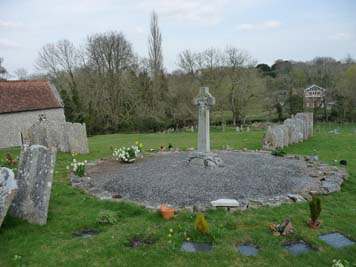 But the most controversial bequest in his will is that Richard left “the house and maulthouse wherein he now dwelleth” to “Thomas Gearle of nether wallop, my sonne in lawe” and ten sheep to each of three Gearle children. Some researches believe Thomas was the husband of an unknown daughter of Richard’s, while others think he was his first wife’s son. It is interesting to note that although he doesn’t mention Gearle’s wife, his supposed daughter’s name, he mentions the three children by name, including the female. In her article on the Kent family printed in The New England Historical and Genealogical Register, Volume 163, Jane Fletcher Fiske states “This was a substantial legacy, and it is possible that Thomas Gearle’s wife was a deceased daughter of Richard Kent, but she is not named and we think it more likely that Thomas was the son of Richard’s first wife and half-brother to his own children.” Richard Kent died sometime prior to November 11, 1609, the date his will was proved. He was buried in the Church of St. Andrew’s churchyard (mouse over image left) in Nether Wallop. His second wife Elizabeth survived him. |
| ~< Back to Chart >~ |
Richard Pyle was probably born about 1519, in Bupton, Wiltshire County, England, the son of William Pyle and his wife Miss Benger (maiden name unknown). There is a deposition he made in December of 1595, where he states his age as 76 years-old. This puts his birth year about 1519, which is much earlier than most researchers estimate his birth to be. There is a Richard Pyle, that may be him, listed under Archers in the North Wiltshire Musters for Anno 30 Henry VIII (1539) for the Hundred of Kynwothstone, in the Towne of Collyngbourn. Richard somehow found his way to Over Wallop, Hampshire County, England. Possibly it was because he was not the eldest son, and moved to make his own way. On August 8, 1549, Richard married Phillis Bassett, of Over Wallop, probably in the church of St. Peter’s (pictured above in Thomas Kent's bio). It is said that they had at least nine children all believed to have been born in Over Wallop – ancestor Ellen; Richard Jr, who is mentioned first in his father’s will; Olive, who died young, was buried on March 12, 1556/7 in Over Wallop; Agnes, who also died young, was buried there on June 10, 1558; John was buried there a few weeks later on June 29, 1558; another son named John, who lived to adulthood, but died in 1576, prior to his father’s will; Edward, who is mentioned in his father’s will; Walter, who married Agnes Osgood, is also mentioned in his father’s will; and Joan, who married Richard Kent Jr (birth order is unknown). Richard, Phillis and their children, probably had a good life, as they had several servants, and he owned other property. We know from his son Richard Jr’s will that ancestor Richard Sr owned “Lands in Lindhurst, held by my father Richard Pyle . . .” There is a Lyndhurst, in Hampshire County just 22 miles south of Over Wallop. (Lyndhurst is where Alice Liddell, the inspiration for Alice in Lewis Carroll's Alice's Adventures in Wonderland, is buried.) In this same will, Richard Jr. left money to “my said sister Ellen Osgoods soones,” John, Stephen and Thomas Kent.
“Weak of body by reason of age. (Long passages showing testator’s extreme piety). All goods and chattels to Richard Pyle my son, whom I make executor. To the cathedral of Winchester, 12d. To the parish church of Upper Wallope, 3s. 4d. To my godchildren, 12d. apiece. To each of my daughters, £10. My son Walter Pyle to hold for life my tenements in Porton wherein he now dwelleth. Reversion to Walter’s wife Agnes during her widowhood, reversion to grandson Richard, son of Walter. To said son Walter, sheep and £20. To son Edward Pyle, 100 sheep in Allington and at Collingborne in co. Wilts, and £6 worth of household stuff, and my lands in Collingborne. To each of my grandchildren, a ewe and 10s. To agnes the now wife of Robert Wards of Choldrington, two sheep. To Richard Rutter of Choldrington, 10s. To my servants, 12d. each. Overseers: Henrye Pyle of Upper Wallop, Robert Whityeers of the same, and Willyam Kent of Russall in co. Wilts, they to have 10s each for their pains.” The will was signed by Richard and witnessed by David Pyle by signature, and the marks of Richard and Henry Osgood. It was proved on November 25, 1605, in Hampshire, by his son Richard Jr. Richard Pyle Sr. was buried on September 9, 1605, in Over Wallop, probably with his wife in St. Peter's Churchyard. In her article on the Pyle family printed in The New England Historical and Genealogical Register, Volume 165, Jane Fletcher Fiske states he was buried as “Richard Pile, housolder.” |
| ~<^>~ |
Phillis Bassett is probably the daughter of Richard and Agnes Bassett of Mottisfont, Hampshire. The village of Mottisfont is about 8 miles south of Over Wallop. Midway between them is the town of Broughton, which is mentioned in several Kent family wills. Mottisfont is also about six miles north west of Romsey, where Phillis’ daughter Ellen Pyle was living as wife of Peter Osgood. The village is best known as the location of Mottisfont Abbey. The only documentation found to date that links Phillis to Richard and Agnes Bassett is Richard Bassett’s will. (Mouse over and click on image left to enlarge in a new window/tab.) In it he mentioned his wife’s name, two daughters, Katheryn and Phillis and a son named Walter. His will is dated August 6, 1550, and it was proved a month later on September 8th. Phillis Bassett Pyle died before her husband and was buried in St. Peter's Churchyard (pictured above) in Over Wallop on January 11, 1594/95. In her article on the Pyle family printed in The New England Historical and Genealogical Register, Volume 165, Jane Fletcher Fiske states she was buried as “the wife of Rich: Pile.” |
| ~< Back to Chart >~ |
Thomas Kent Sr was born about 1500 in Nether Wallop, Hampshire, England, to parents John and Johan Kent. We know he had at least one brother, but probably had many more siblings. From the inventory of his estate, taken when he died, it seems he had a large and successful farm, and he was a man with a good business sense. He owned 220 sheep, cows and other farm animals, plus many men owed him money. Thomas married a woman named Christian, whose maiden name is unknown. They had at least six children, all born in Nether Wallop – eldest son Thomas was born about 1535; Katherine; ancestor Richard; John; Jane; and another unnamed deceased daughter, who was married to John Smythe, because he leaves one cowe and one lambe to evry one of John Smythes children. All of the other children were named in Thomas’ will which was written on “the last daye of october” in 1558. Thomas Sr. left half of the bulk of his estate to his wife and the other half to his son Thomas, but “. . .after the Deathe of Chrystian my wyffe that all suche goodes and Cattylls to be equally dyvydyd that I have gevyn unto hur by this my last wyll unto John Kent Ricd Kent Katern Aloger and Jane Kent my sons and dowthers.” The will is long and difficult to read, but he leaves his wealth divided fairly in detail to all his children, grandchildren, his wife, a niece named Kateryn Kent, and to the church both local and in Winchester. It is interesting to note that just about when Thomas died, Elizabeth I became Queen. Jane Fletcher Fiske tells us in her article printed in New England Historic Genealogical Register Volume 162, that in 1558 four other “Kent men in four different parishes, all evidently sheep farmers died leaving wills . . .” Among them was Thomas’ brother Nicholas. Much of the information here and the excepts of the will were taken from Fiske’s conclusion to this same article, published in volume 163, January 2009 of the Register. |
| ~<^>~ |
William Pyle’s birthdate is unknown, but has been estimated at about 1480. He was born in Wiltshire, England, the only known child of parents Richard and Elizabeth Pile. In The Visitation of Wiltshire, 1623, it is stated that he married a woman whose surname was Benger de Pewsey (of Pewsey). Jane Fletcher Fiske, in her article Pyle Connections printed in volume 165 of the NEHGR, states “daughter of [possibly John] Benger of Pewsey, Wiltshire.” William inherited the Manor of Bupton from his father, but when is not known. Willyam Pyle was listed under Archers in the North Wiltshire Musters for Anno 30 Henry VIII (1539) for the Hundred of Kynwothstone, in the Towne of Collyngbourn. William Pile was also found on the List of Taxpayers for the Benevolence of 1545 for Colingbourne Kingston, and on the List of Taxpayers for the Subsidy of 1576 for the town of Wotton Rivers. Both towns are listed under the Hundred of Kynwarston, which is the same hundred where he was living in 1539. William and his wife had at least three children — Thomas born about 1515, the eldest and heir, married twice; John born about 1517 married Ellen, and was buried in Over Wallop, Hampshire, England in 1577; and ancestor Richard. Fiske suggests there may have been other children, including Elizabeth, who married Richard Parrocke in Over Wallop; and Edward, who was listed under Archers for Overton in the Hundred of Selkeley, in the 1539 North Wiltshire Musters. Unfortunately, nothing more is known about William Pyle and his wife. |
| ~< Back to Chart >~ |
John Kent is the furthest known ancestor in this Kent line. Documentation is virtually non-existent, but wills tell us much. In her article on the Kent Family printed in the New England Historic Genealogical Society Register, Volume 162, Jane Fletcher Fiske writes “The Kents from whom the Newbury settlers came lived in the Wallops, Hampshire; their father was from Over Wallop but their grandfather and great-grandfather were from Nether Wallop, with properties there and in other parishes. The extended family lived in several parishes within a few miles of each other on both sides of the county border between Hampshire and Wiltshire. Most Kent Families had a son Richard or Thomas and usually both, making them difficult to sort out.” John Kent lived in Nether Wallop, Hampshire, England, and married a woman named Johan. They probably had more children, but only two names are known – ancestor Thomas and Nicholas, birth order unknown. John wrote his will on March 15, 1527/8 and probably died shortly afterwards. The will, as printed in Fiske’s continuation of her article in the NEHGSR, volume 163, reads as follows: “In the first instance I bequeath my soul to God Almighty, the lady Virgin Mary and my body to be buried in the churchyard of Saint Andrew of Lower Walope The rest of my goods of this not bequeathed I give and bequeath to Johan my wife whom I constitute ordain and make my lawful executrix in oder she dispose the rest of my goods of this kind, my lawful debts first paid, for the salvation of my soul just as it shall seem best to expedite and to God. I wish that my wife Johan recover of Peter Osgode 2s 4d and of Richard Carter 8d |
| ~<^>~ |
Richard Pile’s ancestry is unknown. What we do know is that he gained a part of the Manor of Bupton by his marriage to Elizabeth Horne, who was one of three co-heirs of her uncle, Thomas Horne’s estate, in the early 1500’s. In bundle 303 (dated from 1504 to 1515) of the Early Chancery Proceedings, 1500-1515, item 56 involves three couples, “Robert Duket, and Elizabeth, his wife, Richard Pyle and Elizabeth, his wife, and Peter Edge and Edith, his wife.” It reads, “Detention of deeds relating to land in Bupton, Yatesbury, Ashtown [Calne], Swindon, Thornhill and Cliffe Pipard, late of Thomas Horn, deceased, brother of the said Elizabeth and Edith, and of Jane, mother of Elizabeth Pyle, his heirs.” From this we learn that Elizabeth’s mother’s name was Jane, and she was a sister, or maybe, a sister-in-law, of the deceased Thomas. If Jane was a sister-in-law of Thomas, she was married to a brother of Thomas, which would make Elizabeth a Horne. But if Jane was a birth sister to Thomas, she could have married anyone, leaving Elizabeth’s maiden name unknown. However, in The Visitation of Wiltshire, 1623, Elizabeth is said to be the daughter of William Horne and sister of a Thomas Horne. This implies that Jane was William’s wife, and the parents of Elizabeth. There are some problems with the visitation record which will be discussed in her parent’s bio, but this researcher believes, Elizabeth was the daughter of William and Jane Horne. Ancestor William is the only known child of Richard and Elizabeth Pyle. Unfortunately, nothing else is known about them. |
| ~< Back to Chart >~ |
Kent Ancestral Towns |
The village contains many old thatched cottages and has been featured in books and TV programs as one of the prettiest villages in England. Dane Cottage on Five Bells Lane was used as Miss Marple's home in the village of St. Mary Mead for the BBC adaptations of the Agatha Christie Miss Marple novels, played by British actress Joan Hickson. The house and many of the surrounding lanes within the village were used as the setting and are commonly seen throughout many of these Miss Marple shows. Nether Wallop's Parish Church, dedicated to St Andrew, was built over 1,000 years ago of flint, stone and brick. It is nestles into a terraced side of a steep chalk hill and overlooks the Wallop Brook on its north and east sides. The burial ground, where so many ancestors were buried adjoins a peaceful mill pond. Inside you can see the only Anglo Saxon wall painting to survive - the precious legacy of artists of the Winchester School who worked here around the year 1020. Over Wallop is a smaller village nearer to the Hampshire/Wiltshire Counties border, also in the Test Valley. It is about 30 miles south from Bupton, in Wiltshire County and about 14 miles north of Romsey. The Wallop Brook runs through the middle of the village with housing on either side of the brook. It was called the other Wallop in the Domesday Book and was described as being smaller than Nether Wallop. The 12th century St. Peter’s Church stands high on the hillside south of the brook. This church has undergone many repairs and alterations which obscure its history, and make it look more Victorian, but one 17th century bench has survived and is at the rear of the church. The parish registers date back to 1538. Romsey is a small market town which lies on the River Test, which is now famous for fly fishing, predominantly trout. Its name is believed to have originated from the term Rūm's Eg, meaning Rūm's area surrounded by marsh. Rūm is probably an abbreviated form of a personal name, like Rūmwald. Romsey Abbey, a large Norman abbey dominates the center of the town. In the 1600's when ancestor Ellen Pyle Kent Osgood lived there, it was a bustling town with growing woolen and tanning industries, milling, and a government of its own. Sadler's Mill, which was built in the 16th century, functioned as a corn and grist mill and has survived with many restorations. During the last restoration in 2005, evidence of an earlier 1650 structure was found and confirmed by carbon 14 dating. |
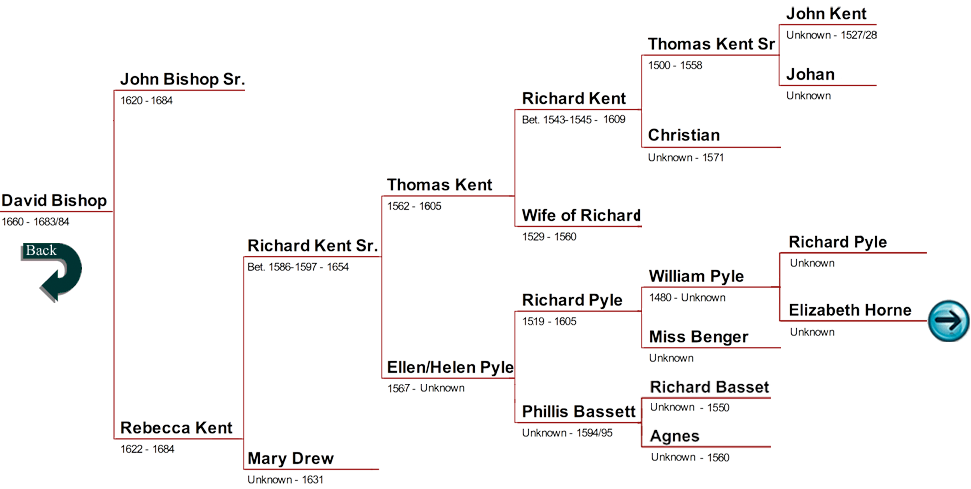
 On October 7, 1647, in Newbury, John married Rebecca (Kent) Scullard, who was the daughter of Richard Kent and widow of Samuel Scullard, one of the founders of Newbury (mouse over image right) and owner of a mill on the Little River. In volume one of the History of Newbury, John James Currier’s tells us that John Bishop “As the lawful successor of Samuel Scullard, deceased, the committee ‘confirmed upon John Bishop his heirs and assigns’ all the rights and privileges originally conveyed by the above-described agreement .” Currier goes on to say that on “June 18, 1663, he sold the mill to Peter Cheney. Thirty years later there was some controversy in regard to the deed of conveyance; and John Bishop denied, May 30, 1682, selling the freehold when he sold the mill.” Volume 4 of the Encyclopedia of Connecticut Biography quotes this sale as “all the mill and millhouse lately erected in Newbury on the little river . . . with the stones, wheel, cog, trough, six mill bills, iron barr, the rope that puts up the stone, and a shop lstely sett up here to ye above said mill.”
On October 7, 1647, in Newbury, John married Rebecca (Kent) Scullard, who was the daughter of Richard Kent and widow of Samuel Scullard, one of the founders of Newbury (mouse over image right) and owner of a mill on the Little River. In volume one of the History of Newbury, John James Currier’s tells us that John Bishop “As the lawful successor of Samuel Scullard, deceased, the committee ‘confirmed upon John Bishop his heirs and assigns’ all the rights and privileges originally conveyed by the above-described agreement .” Currier goes on to say that on “June 18, 1663, he sold the mill to Peter Cheney. Thirty years later there was some controversy in regard to the deed of conveyance; and John Bishop denied, May 30, 1682, selling the freehold when he sold the mill.” Volume 4 of the Encyclopedia of Connecticut Biography quotes this sale as “all the mill and millhouse lately erected in Newbury on the little river . . . with the stones, wheel, cog, trough, six mill bills, iron barr, the rope that puts up the stone, and a shop lstely sett up here to ye above said mill.” Being that there wasn’t a birth record for Martha, only a death record, and after reviewing the original death image record, this researcher believes that Martha wasn’t another daughter. On the original death record, all that can be seen of the given name looks like echa. This researcher believes the name Martha was assumed in error and it was Rebecca, which could be spelled with an h, who died on this date. (Mouse over image right for more info.)
Being that there wasn’t a birth record for Martha, only a death record, and after reviewing the original death image record, this researcher believes that Martha wasn’t another daughter. On the original death record, all that can be seen of the given name looks like echa. This researcher believes the name Martha was assumed in error and it was Rebecca, which could be spelled with an h, who died on this date. (Mouse over image right for more info.)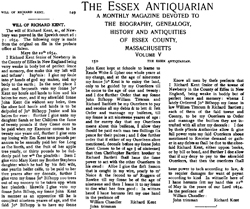
 Richard died in Newbury on June 14, 1654, and his will was proved on September 26th of that year. (Mouse over death record image right for more info.) His widow, Emma died at Newbury on January 10, 1676/7.
Richard died in Newbury on June 14, 1654, and his will was proved on September 26th of that year. (Mouse over death record image right for more info.) His widow, Emma died at Newbury on January 10, 1676/7.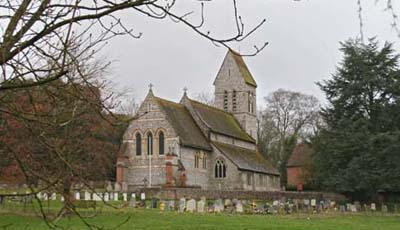
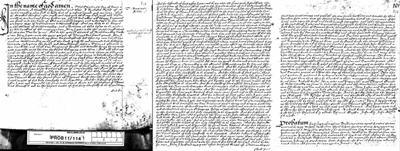
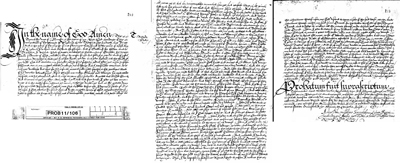

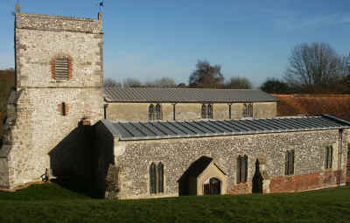 There are two people mentioned after he bequests to his daughter Kateryn’s children named Elizabeth Spreadborouw and a Robt Spradborow, who are probably related. He asks to be buried in the Church of St. Andrew in Nether Wallop, pictured left. The inventory of his estate was done on November 28th, so although his exact date of death is unknown, it was between October 31st and November 28th. His wife Christian died after 1571, as that was the last time her name was on a tithing list for Nether Wallop.
There are two people mentioned after he bequests to his daughter Kateryn’s children named Elizabeth Spreadborouw and a Robt Spradborow, who are probably related. He asks to be buried in the Church of St. Andrew in Nether Wallop, pictured left. The inventory of his estate was done on November 28th, so although his exact date of death is unknown, it was between October 31st and November 28th. His wife Christian died after 1571, as that was the last time her name was on a tithing list for Nether Wallop.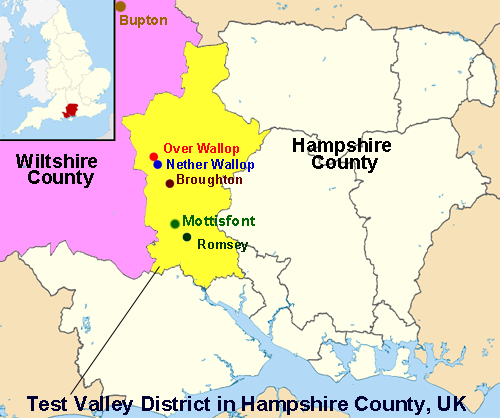 Nether Wallop is a village in the Test Valley in Hampshire County. It is about two miles south of Over Wallop and three miles north of Broughton. The name derives from waella (stream) and hop (valley) or the valley of springing water. The town was the site of the Battle of Guoloph that took place around the year 439. The name Wallop is first used in the Domesday Book of 1086 as Wallope. That became Wollop inferior, and then Nether Wallop, which first came into use about 1270 in Episcopal Registers.
Nether Wallop is a village in the Test Valley in Hampshire County. It is about two miles south of Over Wallop and three miles north of Broughton. The name derives from waella (stream) and hop (valley) or the valley of springing water. The town was the site of the Battle of Guoloph that took place around the year 439. The name Wallop is first used in the Domesday Book of 1086 as Wallope. That became Wollop inferior, and then Nether Wallop, which first came into use about 1270 in Episcopal Registers.